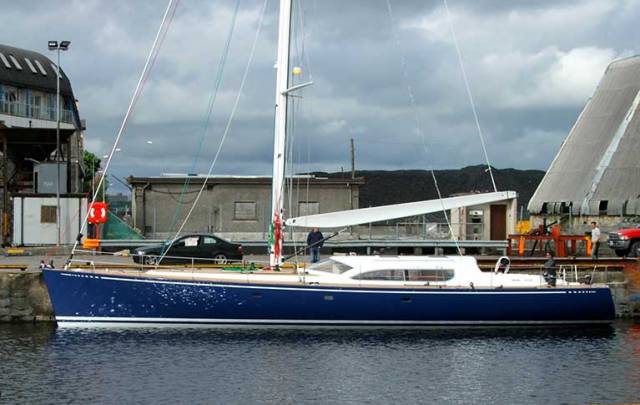There is really no reasonable comparison between Ireland’s eastern and western seaboards writes W M Nixon. The east coast is quite densely populated, and while it has some areas of impressive scenery, in general it lacks the majestic inlets and islands which make sailing the Atlantic seaboard such a joy. That said, there’s no getting away from the fact that, taken overall, the east coast leads in economic activity, and at the very least there’s no doubting it has much less rain.
But when the rain in the west clears to reveal the coastline in all its glory, the extra precipitation seems a small price to pay for such visual natural abundance. And then too, while there are fewer people, they’re all so much larger than life, and bursting with innovative and entertaining ideas, that you’re inclined to think one western person is worth a dozen easterners.
However, those of us living and doing most of our sailing on the humdrum old east coast have one inescapable and total advantage over those in the west. When our east coast life gets too stressed and samey, we can escape for a while to the big country, fresh air and crazy attitudes of the west.
If you live in the west, you simply can’t genuinely experience this moment of release. But on the east coast, if life gets tedious, all that is necessary is head west for a day or two. The moment you cross the River Shannon, the spirits lift, and as you crest the watershed between the Shannon and Galway Bay, the big generous country of the west is rising on the horizon, and all is much better with the world.
In the west, too, they operate on a different time scale. And they do it in a different time zone. Until the railways of the 19th Century made some national co-ordination of time essential, local time meant that the recognised noon was later the further west you moved. As is only natural, Galway was twenty minutes later than Dublin. It was only with the exigencies of the Great War in 1916 that an Official Act was passed making uniform time-keeping a legal requirement. Oddly enough, no-one seems to have discussed what effect this draconian measure might have had in provoking the outbreak of the Easter Rising in 1916. Be that as it may, all we know for now is that in Galway, they still operate on a local time zone which is at least twenty minutes later than everyone else’s time, and is probably nearer half an hour.
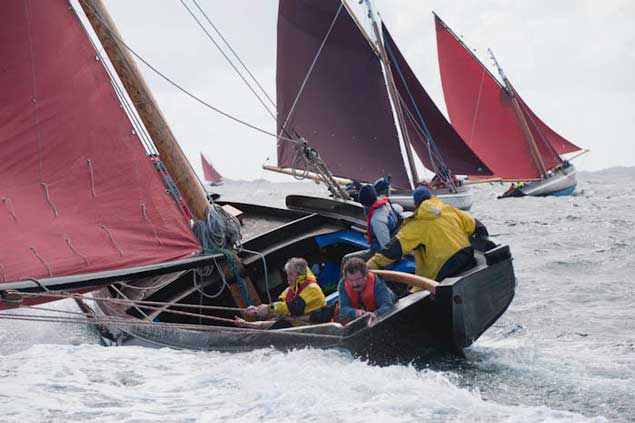 Galway hookers racing hard off the Connemara coast. This is the popular image of sailing in the west, but while vivid and true, the complete story of western sailing is much broader. Photo Paul Harris
Galway hookers racing hard off the Connemara coast. This is the popular image of sailing in the west, but while vivid and true, the complete story of western sailing is much broader. Photo Paul Harris
This became apparent last week when I wheeled into the car park at Galway Bay Sailing Club to give a performance of the current illustrated warblefest, which is about Ireland’s unique relationship with gaff rig and how it has emerged that Irish sailors led the switchover to Bermudan. The details of that will have to wait for another blog, but on this particular night, the immediate concern – with less than a quarter of an hour to go to the advertised start time – was that there just one other car in the car park, and that was Vice Commodore John Murphy, who was there a minute earlier to open the place up for the night.
“Oh Jaysus, Nixon” thought I, “you’ve bombed tonight, there’s not going to be a soul here.” But there wasn’t a moment to brood on the prospect of a showbiz flop, for I was with Pierce Purcell the mover and shaker of the west, and he wanted to show me the almost-finished refurb job they’ve been doing on the ground floor setup in the clubhouse, where they’ve managed to greatly enlarge the floor-space and rationalise its use for a state-of-the art changing room and multiple-use room and boat and equipment store setup.
You know the feeling you get when you’re looking at a job which is going very well indeed. It’s heartening. The re-furb in GBSC is precisely that. It’s being overseen by members Pat and Emer Irwin - he’s the Project Manager and she’s the Architect – and is being done with exemplary efficiency, on time and within a budget of only €160,000, which is the best value in building work I’ve ever seen anywhere.
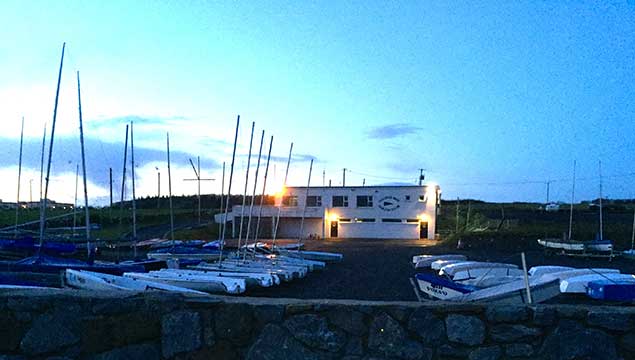 Galway Bay SC is nearing the completion of a clever refurbishment project which is within time, within budget, and excellent value. Photo Pierce Purcell
Galway Bay SC is nearing the completion of a clever refurbishment project which is within time, within budget, and excellent value. Photo Pierce Purcell
We emerged much encouraged from seeing all this to be further cheered by the fact the club was warming up with its famous big stove in the middle of the bar getting into its stride, and the place filling up with people from near and far. For of course I’d temporarily forgotten that Galway’s in a different time zone and it wouldn’t be until around 8.30pm that we’d have some idea of the real turnout, and how effective it might be for the yellow welly collection. This is an idea imported from Poolbeg Y & BC which provides the most painless way of raising funds for the lifeboats. You just provide one yellow RNLI seaboot and request the audience to see how many €5 notes they can get into it. Usually it concludes with some worthwhile figure inevitably ending in either zero or five, but Galway being Galway, the night concluded with the boot yielded up a sum ending with six euro and eight cents……
The show became something we all had to go through with, just in order to justify being there, so it went ahead and finally got to its meandering conclusion. Then the lights went up to reveal even more people had arrived. Pierce Purcell had certainly done his stuff in the phonecall chivvying department, for despite all your modern means of instant total-cover communication, the personal phone call seems to be more important than ever, and the photo below gives some indication of the coverage he achieved, while also hinting at the conviviality of an evening in which a shared love of boats and sailing and a good club atmosphere completely obliterated any feeling of it still being winter outside.
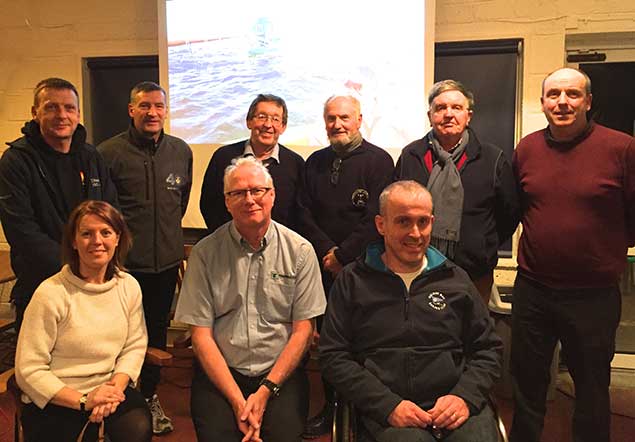 Western gathering. In Galway Bay SC are (back row, left to right) Simon McGibney (Commodore ICRA & ISA Board Member), John Leech (Commodore, Lough Derg YC), Afloat.ie’s W M Nixon, Adrian McConnell (Royal Western YC, Kilrush), Peter Fernie (Rear Commodore Irish Cruising Club) and Richard Glynn (Commodore, Royal Western of Ireland YC). Front row left to right Elaine O’Mahony, (outgoing Hon Sec Foynes YC, 2016 Volvo ISA Training Centre of the Year), Cormac McDonnacha (Chairman, WIORA Week), and Gary Allen, outgoing Commodore GBSC. Photo: Pierce Purcell
Western gathering. In Galway Bay SC are (back row, left to right) Simon McGibney (Commodore ICRA & ISA Board Member), John Leech (Commodore, Lough Derg YC), Afloat.ie’s W M Nixon, Adrian McConnell (Royal Western YC, Kilrush), Peter Fernie (Rear Commodore Irish Cruising Club) and Richard Glynn (Commodore, Royal Western of Ireland YC). Front row left to right Elaine O’Mahony, (outgoing Hon Sec Foynes YC, 2016 Volvo ISA Training Centre of the Year), Cormac McDonnacha (Chairman, WIORA Week), and Gary Allen, outgoing Commodore GBSC. Photo: Pierce Purcell
It was good to talk again with Barry Martin of Galway who made such an impact as bo’sun on the Asgard II many years ago that he found himself being recruited into the same role for both the much larger Britsh sail training schooners Winston Churchill and Malcolm Millar, a job in which he was so successful that he ended his sail training career as a senior officer on the Churchill.
There too were Jim Grealish and Barry Heskin, against whom we used to race inshore and offshore in the days when we each had boats around the 35ft size, boats of very different type yet rating notably similar, so if the Morrisssey-Grealish-Heskin squad appeared on the starting line with Joggernaut, aboard Witchcraft of Howth we knew we were into a boat-for-boat battle in which no quarter would be given, yet everyone would be the best of friends afterwards.
But if there was ample opportunity in GBSC for memories of good times past, equally there was plenty of discussion of the here and now, and it was fascinating to meet up with Dan Mill who runs the busy boatyard in the industrial estate beside Galway Docks. Dan’s story is such that we’ll be developing it into a complete blog in due course, sufficient to say at the moment that his links to Ireland are extraordinarily complex, for although he was born in England, at the age of three his parents together with another family set off to sail to New Zealand from Lymington in the then-bermudan-rigged 43ft Tyrrell ketch Maybird, and Maybird of course is now back in Ireland fully restored as a gaff ketch, and well-known in the ownership of Darryl Hughes.
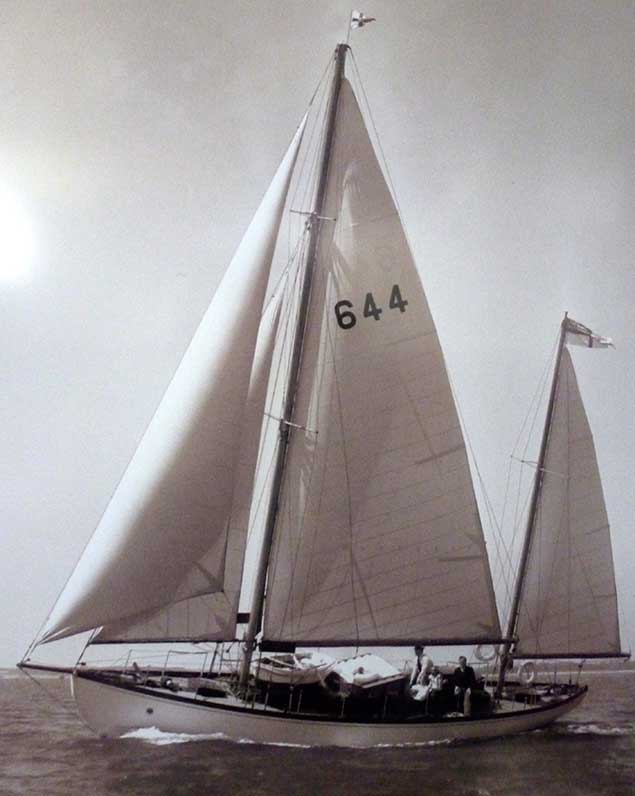 Maybird as a Bermudan ketch. It was under this rig that Dan Mill sailed on her from England to New Zealand while still a child
Maybird as a Bermudan ketch. It was under this rig that Dan Mill sailed on her from England to New Zealand while still a child
As for young Dan, growing up in New Zealand he naturally moved into boat-building in what is probably the best boat-building school in the world, the New Zealand marine industry. But then Mna na hEireann took a hand in his life-path.
It would be difficult to overestimate the influence that the charms of the Women of Ireland have had on the development of a small yet top-level boat-building industry in this country. But there’s something about marine craftsmen and Irish women which gets them together and entices the craftsmen to settle in Ireland despite the fact that, let’s face it, anyone trying to produce such top quality work here is ploughing a lonely furrow a long way from the great centres of the specialist industry, such as the Solent district, parts of the Baltic, certain places in Brittany, and particularly New Zealand.
Yet the women get them, and they get them home to Ireland, and they keep them. Thus we have the likes of Dan Mill in Galway, Steve Morris in Kilrush, and Bill Trafford in the hidden depths of the country near Mitchellstown, all three of them trying to ensure work of the highest quality in a country where “Ah sure, ’twill do” is sometimes the defining motto in woodwork.
Having arrived in Galway, Dan Mill found himself within the orbit of the formidable John Killeen, with whom all ideas are possible, and somehow they found themselves setting out to build a cruising version of an Open 60.
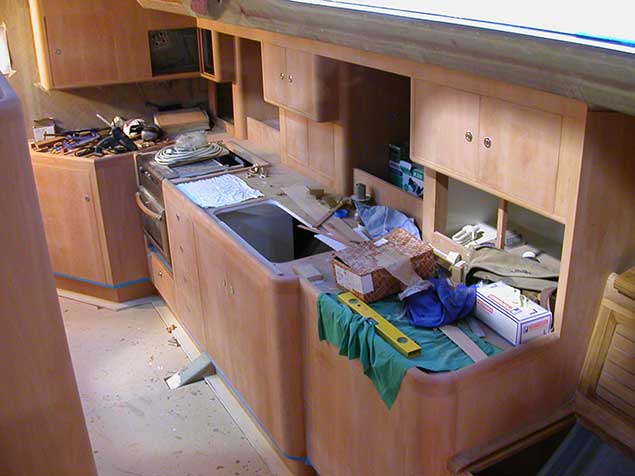 The galley area in Nimmo under construction
The galley area in Nimmo under construction
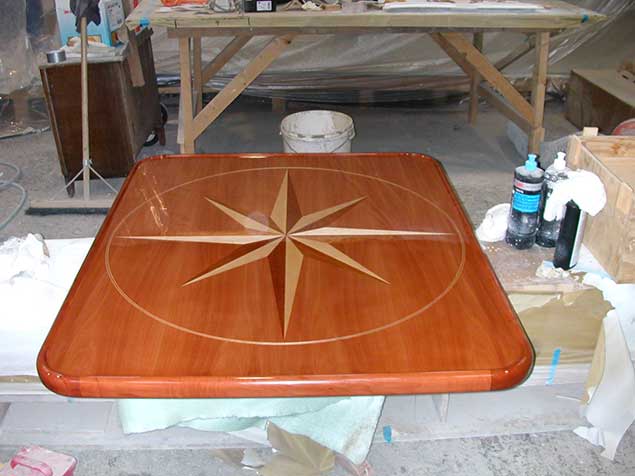 Beauty in detail – Dan Mill’s craftsmanship in evidence on a table for Nimmo.
Beauty in detail – Dan Mill’s craftsmanship in evidence on a table for Nimmo.
In the end she became a very one-off 68-footer named Nimmo in honour of the great Scottish harbour engineer Alexander Nimmo, who is one of John’s heroes. When she was eventually finished after four years with Dan being responsible for virtually every bit of skilled work in her complex construction and superb finish, he was exhausted, but his reputation in Galway was well established at a very high level, and he’s now the man to go to with boat maintenance needs and problems. He’s not above undertaking a mid-level job such as putting a new deck and coachroof on an older fibreglass hull, but as for launching another project on the Nimmo scale, that would require some thinking about.
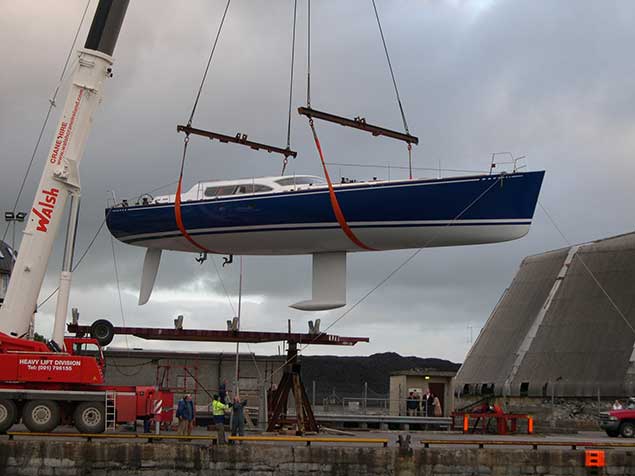 Launching day for Nimmo, built in a very basic shed in Galway
Launching day for Nimmo, built in a very basic shed in Galway Dan Mill this week in the boat yard in Galway
Dan Mill this week in the boat yard in Galway
Nevertheless, talking with the man who built Nimmo was an eloquent reminder that there’s a lot more to sailing in the West than Galway Hookers and other traditional craft. But equally it was a reminder that the traditional skills are still being maintained and indeed nourished out beyond the Pale. So after a leisurely breakfast next morning with Pierce and Susan Purcell in their dream house in Clarinbridge, with a busy red squirrel feasting on the bird table close outside the generous window, there was time to inspect Pierce’s boatshed out the back, one of those green steel sheds which sit so well in the Irish countryside, particularly when – like Pierce – you have your 26-footer comfortably winterised in it, and a fine well-equipped workbench right to hand.
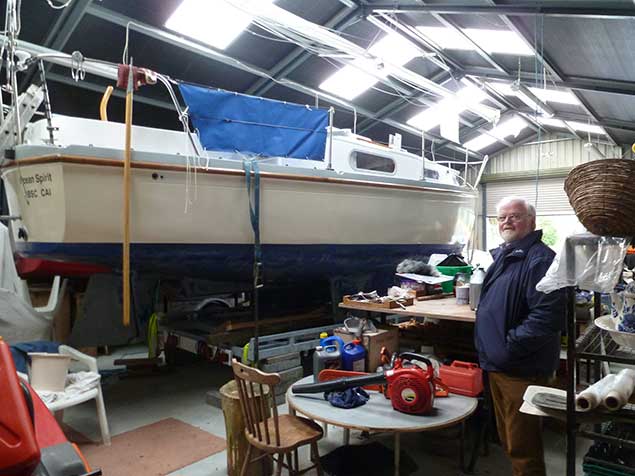 What price a facility like this at your house on the East Coast? Pierce Purcell in “the little shed out the back” at Clarenbridge Photo W M Nixon
What price a facility like this at your house on the East Coast? Pierce Purcell in “the little shed out the back” at Clarenbridge Photo W M Nixon
It’s the sort of ideal setup very few can manage on the over-crowded East Coast, and I headed south musing on the east-west imbalance, and readying the thinking for something entirely different - the Ilen Boat-Building School in Limerick. This started as the backup service for the restoration of the Conor O’Brien 57ft ketch Ilen by Liam Hegarty at Oldcourt near Baltimore, and recently in the Ilen School they’ve produced deckhouses for Ilen to the highest standard, and are currently finishing the last of the new spars.
But under the inspiration of Gary MacMahon (who personally was responsible for bring Ilen home from the Falklands) and others such as Brother Anthony Keane of Glenstal Abbey, the Ilen School has become a remarkable educational and training resource undertaking a wide variety of projects such as creating replicas of the traditional Shannon Estuary gandelows, and building a class of the very handy CityOne sailing dinghies to a design by the late Theo Rye, a successful project which further revealed the multiple talents of that much-mourned expert in every aspect of naval architecture.
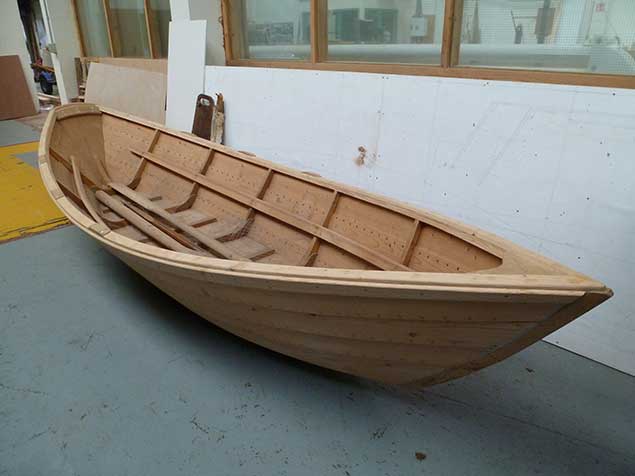 Courses constructing traditional Grand Banks Dories provide popular night classes at the Ilen Boatbuilding School in Limerick. Photo W M Nixon
Courses constructing traditional Grand Banks Dories provide popular night classes at the Ilen Boatbuilding School in Limerick. Photo W M Nixon
Another handy course which the Ilen School offers is through building traditional Grand Banks dories, simple yet effective boats which must have seemed very small indeed as you were left behind in the Grand Banks fog by the Bluenose fishing schooners to get on with the day’s business of ling-lining for cod. By the time the schooner found you again towards evening, your little dory would be dangerously laden with a great catch of wet and scaly silvery wealth.
In fact, the Ilen School is a whole host of experiences, for there in the main work-space were the mighty new spars for Ilen together with the distinctly aged original gaff which goes all the way back to Tom Moynihan and his shipwrights in Baltimore 91 years ago. And in another workspace, the Ilen team are building two very able little dinghies to the Valentine type from dimensions supplied by Hal Sisk, and they will in time be Ilen’s boats. But before you get to these sensibly–shaped little dinghies, you’ve to take on board the Hildasay, the Ilen school’s latest acquisition.
 The Valentine dinghy, from plans provided by Hal Sisk, has been built at the school to be a ship’s boat for Ilen. Photo W M Nixon
The Valentine dinghy, from plans provided by Hal Sisk, has been built at the school to be a ship’s boat for Ilen. Photo W M Nixon
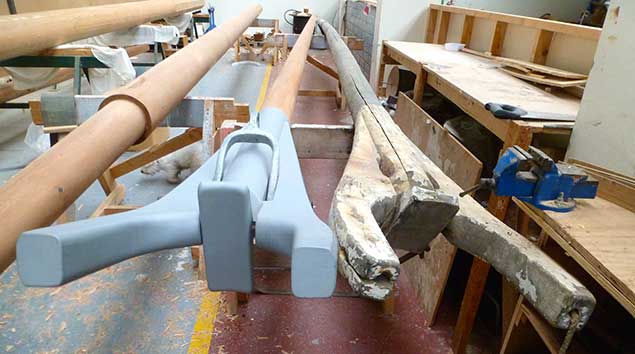 Ilen’s new main gaff boom (left) and the original (right), which was shaped in Baltimore in 1926. Photo W M Nixon
Ilen’s new main gaff boom (left) and the original (right), which was shaped in Baltimore in 1926. Photo W M Nixon
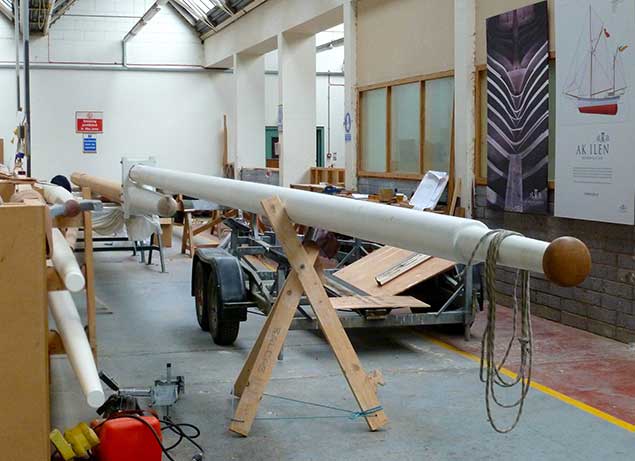 The mighty mainmast for Ilen, with topmast temporarily in place in Limerick, is ready for dismantling and transport to Baltimore. Photo W M Nixon
The mighty mainmast for Ilen, with topmast temporarily in place in Limerick, is ready for dismantling and transport to Baltimore. Photo W M Nixon
We all know that Limerick is a Viking city, in fact there are those who would argue that it still is, and in its rawest state too. But nevertheless it takes a while to get your head round how a boat like Hildasay, of the very purest Viking descent, should have ended up in a big shed in a trading estate in Limerick.
Hildasay was built in Shetland as a sailing development of the traditional clinker-built sixareen (six oars) in 1951, and is such a sweet little 26-footer that your heart falls for her, even if your head tells you that the slim Viking stern mean there’s very little space just where you most need it most, while the classic clinker construction poses its own special maintenance problems in a vessel which is a semi-keelboat.
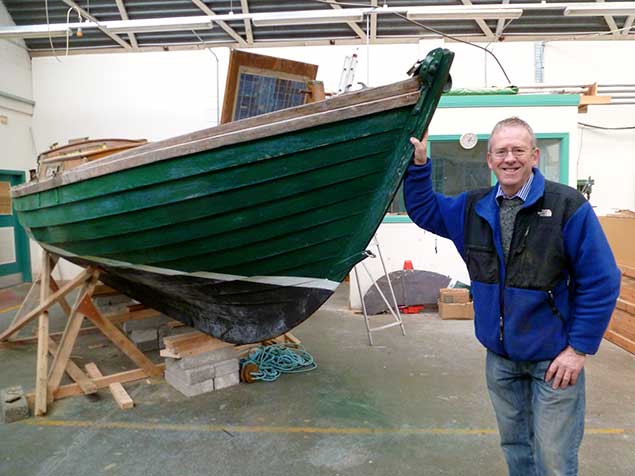 Jack Hawks with the Shetland sailing sixareen Hildasay, whuch he has donated to the Ilen Boatbuilding School. Photo: W M Nixon
Jack Hawks with the Shetland sailing sixareen Hildasay, whuch he has donated to the Ilen Boatbuilding School. Photo: W M Nixon
She has been in and around the Shannon Estuary for abut 15 years, but owner Jack Hawks was recently seriously ill, and though he has fully recovered he felt the demands of Hildasay were getting a little too much for him, and wondered if the Ilen Boat Building School would be interested in her as a gift.
She’s an ideal gift, as she’s of a size to be very manageable, she provides special maintenance problems which, while not enormous, are very educational as part of the school’s courses, and each summer when she’s in commission she could be based either on Lough Derg, or somewhere down the Estuary.
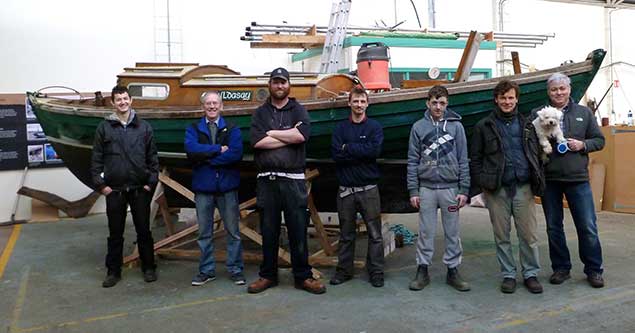 The “day team” at the Ilen School with their new acquisition Hildasay include Luki O’Brien, Jack Hawks, Elan Bromley, Owen Lacey, Sid Dorchenas, Matt Diss, Gary MacMahon and Luna MacMahon. Photo W M Nixon
The “day team” at the Ilen School with their new acquisition Hildasay include Luki O’Brien, Jack Hawks, Elan Bromley, Owen Lacey, Sid Dorchenas, Matt Diss, Gary MacMahon and Luna MacMahon. Photo W M Nixon
The problem in Limerick is that though the Shannon is very much in the midst of it, access to it in the heart of town is limited, and in any case below the weir the big tides are a problem. But up on Lough Derg or further down the Estuary, there are all sorts of opportunities to get conveniently afloat, and having the use of an interesting sailing boat which is bigger than a CityOne or a gandelow is a natural add-on to the Ilen School’s activities, providing a broadening of the mind for some young would-be boatbuilders who may have spent too much time solely at the workbench without seeing what the resulting use of the end product is all about. And who knows, but they might even manage a race with the lovely gaff cutter Sally O’Keeffe built by Steve Morris of Kilrush with the community team from nearby Querrin as a replica of the traditional Shannon Estuary trading hooker.
Having seen the possibilities of mind-broadening in Limerick, the final part of this western tour took in a project which is mind-blowing. Admittedly the good people of the townland of Skenakilla would never for a minute think of themselves as being in the west, but for the rest of us this hidden spot beyond Mitchellstown in North Cork seems to be in the middle of nowhere. But then when you’ve found it, and spent a bit of time with the ebullient Bill Trafford in his remarkable Alchemy Marine boat workshop in Skenakilla, you feel you’re at the hub of the universe.
Bill is another case of Mna na hEireann reeling them in – a classic yachtbuilder and particularly an enthusiast for the International 6 Metre Class, he met an Irish girl and that was that. He made a living plying his highly specialized trade the length and breadth of our island working from a van, and then discovered his own niche in doing interesting, indeed extraordinary things, with old fibreglass boats.
 Bill Trafford’s transformation of an Elizabethan 23 won international awards last year.
Bill Trafford’s transformation of an Elizabethan 23 won international awards last year.
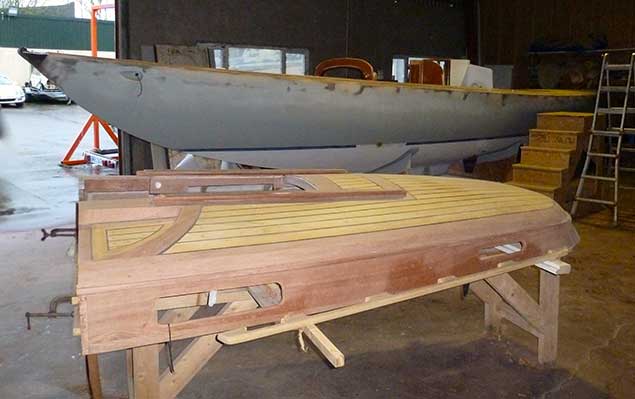 Bill Trafford’s current project at Alchemy Marine is the transformation of an Etchells 22 into a weekend cruiser by raising the freeboard, and providing a beautifully-made coachroof (foreground) Photo: W M Nixon
Bill Trafford’s current project at Alchemy Marine is the transformation of an Etchells 22 into a weekend cruiser by raising the freeboard, and providing a beautifully-made coachroof (foreground) Photo: W M Nixon
 Bill Trafford – he is as enthusiastic about the full potential of glassfibre construction as he is about using classic yacht joinery work. Photo W M Nixon
Bill Trafford – he is as enthusiastic about the full potential of glassfibre construction as he is about using classic yacht joinery work. Photo W M Nixon
He’s unusual in that he’s as enthusiastic about the wide potential of glassfibre construction as he is profoundly satisfied by working in wood to the highest classic yacht standards. While his special abilities were well known to a select few, he came to international notice last year when one of his masterpieces, the complete re-working of a seemingly tired little Elizabthan 23 into an elegant 26ft sloop with a classic New England style, was awarded a top prize in the Classic Boat annual competition.
His current project for a Cork owner is even more intriguing, the transformation of an ordinary and no longer young Etchells 22 into a 34ft LOA day cruiser of unique appearance. He has raised the topsides using glassfibre moulding to give her a completely fresh sheerline, he has transformed the stern by giving it a new-look counter with a curving transom which gives more than a nod in the direction of the unique sterns of the Friendship sloops of Maine, and he has built the most beautiful coachroof in the best Knud Reimers style to provide a boat which comes with a heady combination of Down East and Scandinavia to her.
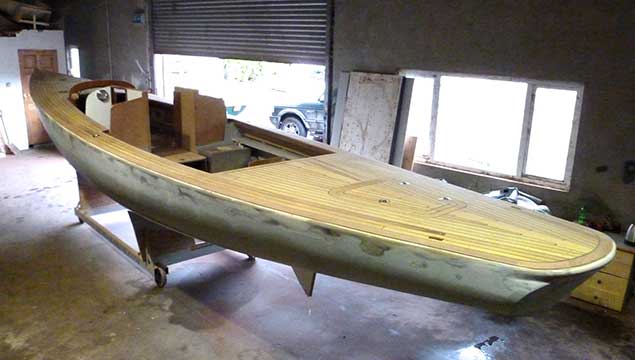 The lengthened stern has seen the rudder being moved aft by half a metre to provide a much roomier cockpit. Photo: W M Nixon
The lengthened stern has seen the rudder being moved aft by half a metre to provide a much roomier cockpit. Photo: W M Nixon
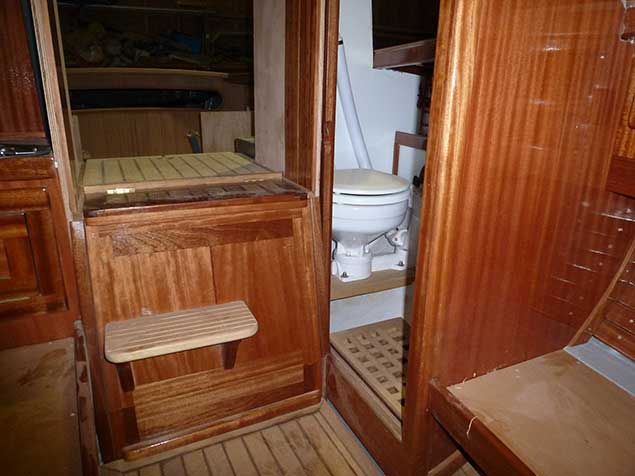 While compact, the accommodation provides for weekend cruising, but it’s expected to be comfortable day sailing which will be the best use of the “new” boat. Photo: W M Nixon
While compact, the accommodation provides for weekend cruising, but it’s expected to be comfortable day sailing which will be the best use of the “new” boat. Photo: W M Nixon
The stern is lengthened such that the LOA is now 34ft instead of the original 30.5ft, and the possibilities this has provided for a large cockpit to match the very pleasant accommodation (including a proper toilet compartment and a Beta diesel auxiliary) have been met by moving the entire rudder half a metre aft.
With his experience of tweaking boats this way and that, Bill reckons the sailing balance will if anything be improved by this re-location of the rudder. Personally, in the standard Etchells I’d always thought it too far forward anyway, so I could live with this change, yet found it entertaining to note that while he talked of moving the rudder aft by half a metre, when I asked him how he calculated the perfect-looking camber in the new deck, he said his rule of thumb is one inch for every four feet of beam. This is as near as dammit one in fifty, but his mixture of measurement systems makes him just like the rest of us who are mere bodgers, for when we’re measuring something we just use the side of the steel rule which comes up first, be it metric or imperial…….
 Under the new foredeck – Bill’s rule of thumb is a deck camber of one in 48. Photo: W M Nixon
Under the new foredeck – Bill’s rule of thumb is a deck camber of one in 48. Photo: W M Nixon
This is very much a bespoke project, so Bill has been able to introduce all sorts of quirky little features, a very attractive one being the ports for the navigation lights, which are set well into the hull either side of the stemhead, and look for all the world like the eyes put in Mediterranean boats to ward off evil spirits. In fact, they give such an appearance of good cheer to this new-old boat that when you see her from ahead, she looks for all the world as though she is smiling so much that she’s about to burst out laughing.
 The Watchful One…….it was a Bill Trafford’s idea to build special ports for the navigation lights. Photo W M Nixon
The Watchful One…….it was a Bill Trafford’s idea to build special ports for the navigation lights. Photo W M Nixon
There’s still quite a bit to do before she’s ready for the water, but Bill is now in such a rhythm of working on his own that he can put in long productive hours without really noticing it, so we hope to get back to Skenakilla sooner rather than later. As for those around him, one unexpected advantage of being near Mitchellstown is you’re right in the heart of the dairy engineering industry, where the use and working of stainless steel is second nature. In fact, down there they sometimes use stainless steel which is of a superior grade to the 316 which is usually good enough for the rest of us.
Truth to tell, I didn’t know there were types of stainless steel superior to 316, but you learn many things down in Skenakilla, and it was encouraging to hear that the best workers in the stainless steel fabricating shops are happy to lend their skills in their spare time to bring Bill’s self-made stainless steel fittings up to professional standards of finish.
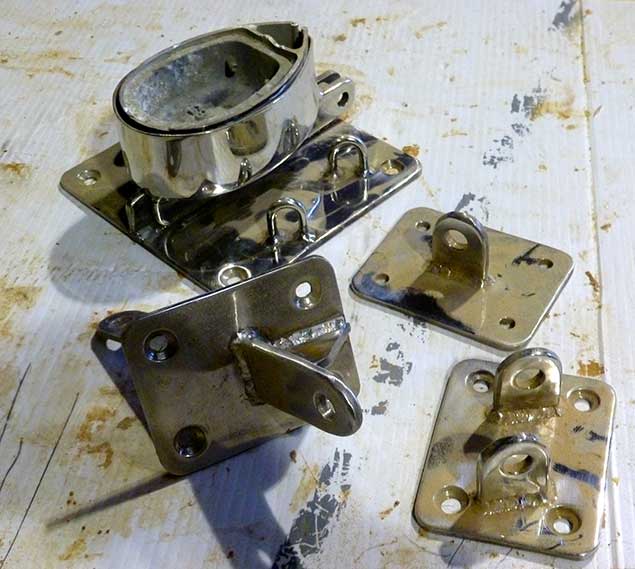 Thanks to the local presence of high-grade stainless steel engineering for the dairy industry, it has been possible to make these fittings in Skenakilla. Photo: W M Nixon
Thanks to the local presence of high-grade stainless steel engineering for the dairy industry, it has been possible to make these fittings in Skenakilla. Photo: W M Nixon
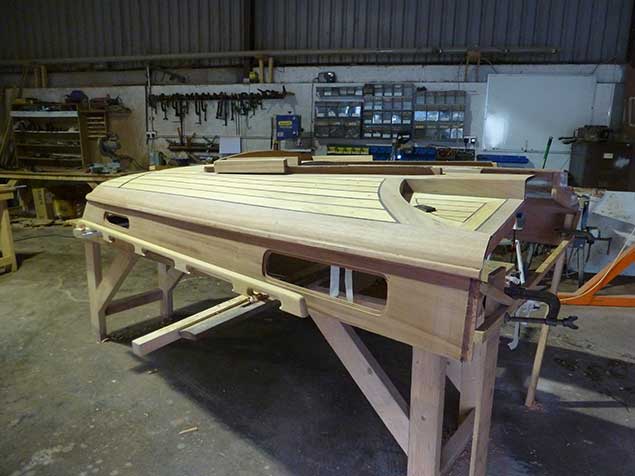 A work of art in its own right, the new coachroof will be fitted any day now. Photo: W M Nixon
A work of art in its own right, the new coachroof will be fitted any day now. Photo: W M Nixon
All being well, the new boat will be a star at the 25th Anniversary Glandore Classics Regatta from July 23rd to 29th, in fact Bill rather hopes the owner might consider taking her to the Classics Regatta celebrating the Bicentenary of Dun Laoghaire Harbour from July 6th to 9th as part of Volvo Dun Laoghaire Regatta.
The good news here is that Cathy MacAleavey, chair of the Dun Laoghaire Classics organising committee, and Sally Wyles, who heads up the Glandore organisation, got together last weekend to see about selling their two events as a sort of package, as the clear fortnight between them makes participation in both a very realistic proposition.
Certainly the Dun Laoghaire Classics is beginning to look impressive, particularly if you go by the measuring method of counting the number of famous designers involved. The recent interest shown by Rob Mason of Milford Haven to come over with his newly-restored 36ft Alexander Richardson-designed 36ft Myfanwy brings a once-famous Liverpool designer back into the limelight. It’s where he deserves to be, for Richardson designed John Jameson’s all-conquering Irex in 1884.
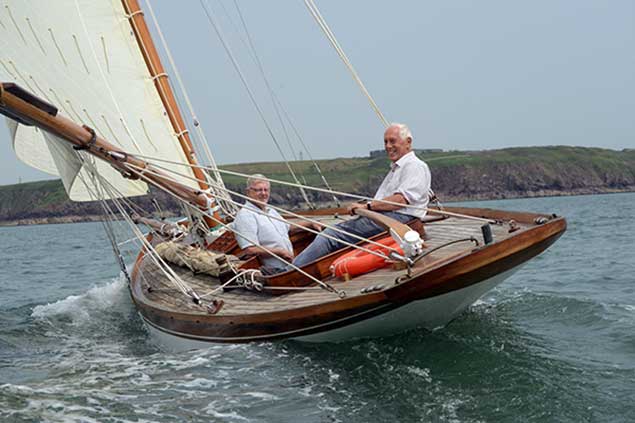 Rob Mason with his restored 1897 Alexander Richardson 36-footer Myfanwy off Milford Haven. He has indicated interest in participation in the Bicentenary Regatta in Dun Laoghaire in July
Rob Mason with his restored 1897 Alexander Richardson 36-footer Myfanwy off Milford Haven. He has indicated interest in participation in the Bicentenary Regatta in Dun Laoghaire in July
In Dublin Bay, Myfanwy would see this Richardson creation shaping up to designs by G L Watson, Alfred Mylne, William Fife, John Kearney, O’Brien Kennedy, Arthur Robb and others, and that’s the list already with the net only newly cast.
As for what Glandore can offer, there’s at least one unique proposition. A special race will be sailed to honour the memory of Theo Rye, the fleet including the CityOnes from Limerick and a host of other boats, new and old. On each and every one of them, Theo would have had something new and of real interest to say, for that’s the kind of devoted student of naval architecture he was throughout his far-too-short life. He is much missed.
 Much missed. The late Theo Rye aboard the 1887 Fife cutter Ayrshire Lass, which was restored by Michael Kennedy at Dunmore East. Theo Rye will be commemorated in a special event at the 25th Anniversary Glandore Classics Regatta from July 23rd to 29th. Photo: Darryl Hughes
Much missed. The late Theo Rye aboard the 1887 Fife cutter Ayrshire Lass, which was restored by Michael Kennedy at Dunmore East. Theo Rye will be commemorated in a special event at the 25th Anniversary Glandore Classics Regatta from July 23rd to 29th. Photo: Darryl Hughes



























